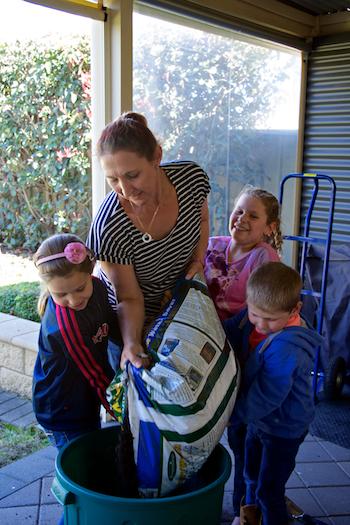Topping up the soil
Duration/age

Spring has arrived and it’s time to plant new seedlings.
Before you plant the next lot of seedlings do you need to add more soil to the pots? Has the soil gradually disappeared leaving the pot half full?
How will you go about filling up the pots? Will you buy bags of soil from the garden centre or will you have a trailer load of soil delivered? If you get a trailer load will it be all hands on deck, shovelling and moving the soil?
We have 20 pots to fill so everyone will need to help shovel the soil.
We only have 2 small pots to fill so we will only need 1 bag of soil.
Talk to your child about how much to fill up the pots. Will you go to the top or leave some space?
Don’t fill it to the top because there won’t be room to plant the seedlings.
As you and your child work together count how many buckets or wheelbarrows you have filled. Who has filled the most?
You have filled 10 buckets. I have filled 2 wheelbarrows. The wheelbarrow is bigger and holds more.
Materials you will need
- Pots
- Spade
- Soil
- Shovel
- Wheelbarrow
Alternative tools
- Bucket
- Potting mix
Skills this activity improves
Why does this matter?
Working with you to top up the pots helps your child to develop observation skills and to notice differences and changes in the environment. As they notice the changes to the soil level in the pots they will be using mathematical language and measurement to describe what they see.
Helping to top up the pots helps children to develop spatial awareness and motor skills. Each time they scoop up the soil and put it into the bucket, wheelbarrow or pot they are exploring position, location and movement.
What does this lead to?
Talking about what they are doing - like counting how many scoops they have put in the bucket or how full to fill the pot - helps children to develop the different language we use to measure and compare objects.
As they carefully scoop, tip and pour the soil into the containers they are learning to move their bodies in space. Each time they lift or pour the bucket they are experimenting with where to locate their body in relation to the bucket and the pot.
Language to use
- Soil, spade, pot, wheelbarrow, bucket
- Full, empty, half full
- Top, side, edge
- Counting
- Scooping, digging, filling, pushing, carrying
- Capacity, volume
Questions to use
- How many pots do we need to fill?
- How close to the top is the soil?
- How many buckets of soil does it take to fill the pot?
- Who has the bigger spade?
- How full can you fill the wheelbarrow before you can’t push it?
Useful tips
- You might also like to take a look at the activities Planting a garden you can eat and Trickle, drip, splash.
- If the bucket is too heavy you could carry it together.
- Remember to talk to your child in your home language.
More ideas
- Get your child to fill their own containers and plant their own seedlings.
- Set up a digging patch at home.
Variation by age
Birth to two year olds
- On wet days you could set up a sand tray inside. Try digging with spoons that are different sizes.
- Bury treasure in a sand tray, but don’t tell your child. They will get an enormous surprise when they dig up the treasure.
- Set up a water tray with pots and containers of different shapes and sizes.
- Fill buckets and containers with sand in the sandpit.
Three to five year olds
- On wet days you could set up a sand tray inside. Try digging with spoons that are different sizes.
- Bury treasure in a sand tray, but don’t tell your child. They will get an enormous surprise when they dig up the treasure.
- Make a treasure map. Bury treasure to find at different points along the way.
- Make your own scales to weigh the buckets.
- Make a tally sheet and record how many buckets you have filled.
Questions to ask
- Which one is bigger?
- Which one is smaller?
- How many are there?
Questions to ask
- Who has filled the most buckets?
- What do you think is under the soil?
- Which container will hold more?
- Which container will hold the least?
- Which container is the heaviest?
Language to use
- Full, empty
- Bigger, smaller
- Heavy, light
Language to use
- More, less, same, equal
- Above, below, under, on
- Most, least, same, different
- Heavy, light


